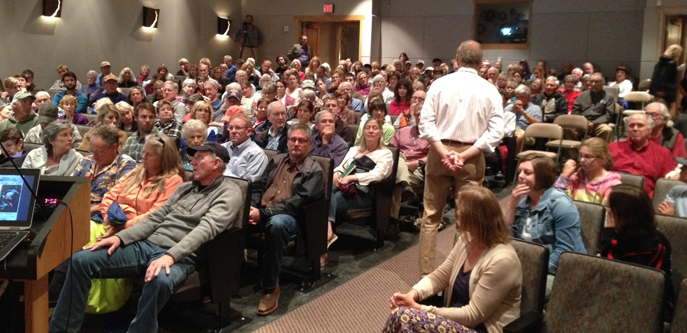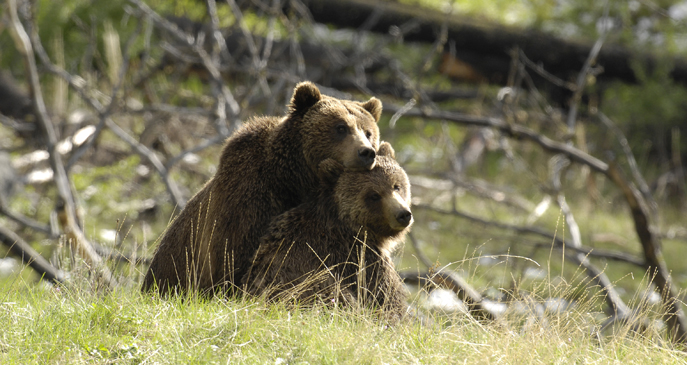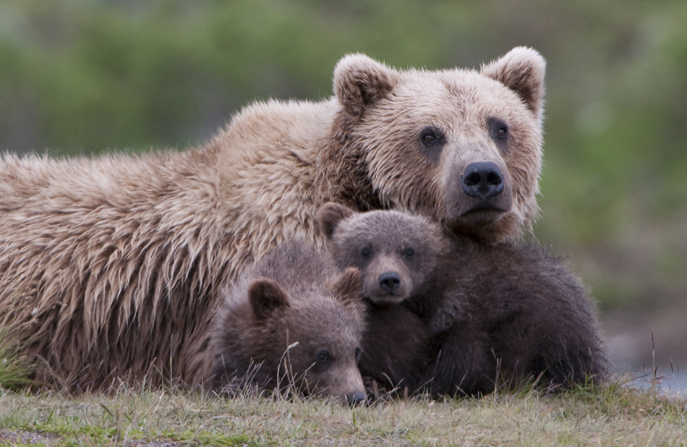On a recent summer evening in Jackson, Wyoming, nearly 250 people packed into the National Museum of Wildlife Art auditorium for the "The Changing World of Greater Yellowstone’s Grizzly Bears," a special event organized by Sierra Club, Wyoming Wildlife Advocates, the Cougar Fund, and the Center for Biological Diversity. The lights went down, the crowd quieted, and the anticipation was palpable as a beautiful grizzly bear filled the screen. With the spectacular Tetons as a backdrop, images of "Grizzly 399" -– arguably the region's best-known and well-loved grizzly bear –- with her tiny cubs by her side kept us captivated throughout "Always Endangered," a short film created by Jackson filmmaker Jim Laybourn. Smiles broke out during scenes of people jumping up and down in excitement at their first-ever glimpse of grizzly bears in their natural home –- a feeling to which we could all relate. But there was a serious overtone, too: Laybourn made the film to call attention to the vulnerability of 399 and her family, and the threats that they and other grizzlies of Greater Yellowstone face.

The Jackson event was part of a public outreach campaign that the Sierra Club launched earlier this year to raise awareness about how special Greater Yellowstone's grizzly bears are, the significant changes that are affecting their habitat, and the serious implications those changes hold for the bears' future. We believe that it's imperative for people to have the full picture so they can make informed decisions and engage in the debate over whether or not to remove Endangered Species Act protections ("delisting") from this beloved grizzly bear population.

As the film ended and the lights came up, renowned grizzly bear expert Dr. David Mattson took the stage to walk us through the many habitat changes that bears are facing, and to give his perspective on the implications for the population. Dr. Mattson has spent much of his life studying the ecology and management of large carnivores including grizzly bears in the Yellowstone region. For nearly a decade he had primary responsibility as a member of the Interagency Grizzly Bear Study Team for investigating grizzly bear diet, habitat use, and relationships with humans, annually covering more than 1,500 miles on foot in the backcountry tracking grizzlies and their habitat. His passion for grizzly bears was evident throughout an engaging hour-long presentation and subsequent lively question and answer session.
Many in the audience were surprised to learn that Greater Yellowstone's grizzly bears are unique in the world. No other grizzlies eat the variety of foods and exhibit the behaviors that bears here do. But as Dr. Mattson explained, grizzlies in this region historically have been primarily dependent on four key food sources: seeds from whitebark pine trees, Yellowstone cutthroat trout, army cutworm moths, and meat (mostly elk and bison calves and carcasses). Over the last 10 years the availability of two of these important food sources has declined dramatically: whitebark pine is now almost completely gone from the ecosystem due to unprecedented outbreaks of pine beetles and blister rust, and cutthroat trout populations have been decimated by invasive, non-native lake trout. In some areas, elk and bison populations have decreased and are therefore less available to bears, and the outlook is bleak for army cutworm moths in a warming climate.
One of the most troubling implications of the loss of historical foods such as whitebark pine, which grows at high elevations and keeps bears away from human development, is that bears are looking for more meat to replace those lost calories –- specifically, carcasses of hunter-killed elk, and livestock -– and getting into more conflicts with hunters and ranchers as a result. More conflicts mean that more bears are being intentionally killed, and as Dr. Mattson noted, there is a clear trend of rising mortalities corresponding to the decline of whitebark pine. Grizzly bears reproduce very slowly; generally a female only replaces herself once in the first 10 years of her life. Consequently, even a small amount of female mortality can have profound effects on the population for decades to come.
What we hear repeatedly from federal and state agencies these days is that everything is fine with Greater Yellowstone's grizzly bears; they'll find other foods to eat, their numbers are strong and the population can sustain higher mortality, and the Yellowstone grizzly population is recovered and should be delisted. But are alternate foods nutritionally comparable, and are there higher risks to bears seeking out those alternate foods? And are we seeing more bears on the periphery of the ecosystem because "the ecosystem is full," as the agencies are saying, or –- as Dr. Mattson believes is more likely –- because there is a "hollowing out" of the core due to key foods being lost, so bears now must search farther out into surrounding areas for replacement foods?
What this all comes down to is two things; there are some profound questions that need to be answered before we contemplate removing federal Endangered Species Act protections for Yellowstone grizzly bears, and we know enough now about other aspects to oppose delisting, including:
- The growth rate of the Greater Yellowstone grizzly bear population has been flat since the early 2000s, and may be in decline. Fewer cubs and yearlings are surviving to adulthood.
- Grizzly bears in the Yellowstone region are completely isolated from other grizzly bear populations, both geographically and demographically, as they have been for 100 years.
- Existing state management plans will not protect Yellowstone grizzly bears and will not allow them to connect to other grizzly populations if they are delisted now. Wyoming, Montana, and Idaho, the three states where Yellowstone grizzly bears live, plan to immediately initiate sport hunting of grizzly bears as soon as they are delisted.
- Courts have ruled that the U.S. Fish and Wildlife Service must consider the overall recovery of the species as it was originally listed under the Endangered Species Act, and may not delist isolated segments of the species (such as the Greater Yellowstone grizzly population) one at a time.
(Read this fact sheet on Grizzly Bear Recovery and Endangered Species Act Protection.)
Just as important as the scientific and legal reasons are the cultural reasons to oppose delisting. We have long-standing connections to the great bear; grizzlies figure prominently in our stories and myths. We are fascinated, awed, sometimes scared, and humbled by grizzly bears –- as we should be –- and they are revered by many. Native American tribes consider the grizzly to be sacred, and a powerful symbol of spiritual regeneration and renewal. An astounding number of tribes -– 35 to date -– have passed formal resolutions opposing delisting of the Yellowstone grizzly bear. But their voices are being ignored; the U.S. Fish and Wildlife Service has not honored requirements to consult with Native American tribes on delisting, despite Presidential Executive Orders and laws requiring them to involve tribes on matters affecting them. The Sierra Club strongly supports the tribes in their call for formal government-to-government consultation on grizzly delisting. (Take action here -- and watch this video, below, from the leaders of the Blackfoot Confederacy speaking out against delisting of the sacred grizzly bear.)
Dr. Mattson concluded his presentation that evening with the question, "What's the rush on delisting?" Good question. Because grizzly bears reproduce so slowly, it typically takes at least a decade before effects start showing up in the population. We don't know yet the full effects of losing such a critical food resource like whitebark pine; the peak of the decline was within the last 10 years. It has taken 40 years of Endangered Species Act protections for grizzly bears to begin making a comeback in the Yellowstone region. This is not a time to take chances with this majestic species, particularly after so much time and money has been spent to recover grizzly bears -- the ultimate symbol of our wild heritage, and to many Native Americans and others, the physical embodiment of the very spirit of the earth itself. And it's no time to allow this amazing being -- which today occupies less than 2 percent of its historic range in the lower 48 states -- to be hunted for "sport."
Find out more and take action to protect Greater Yellowstone's grizzly bears.
